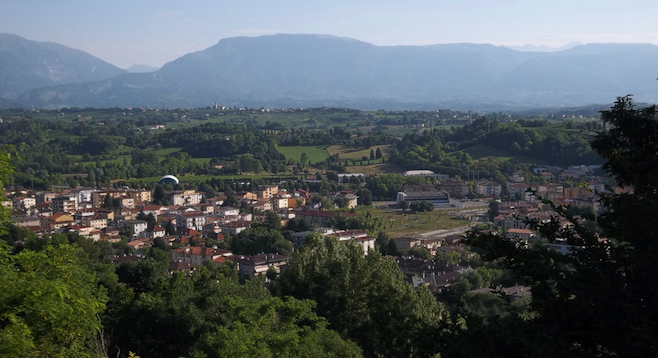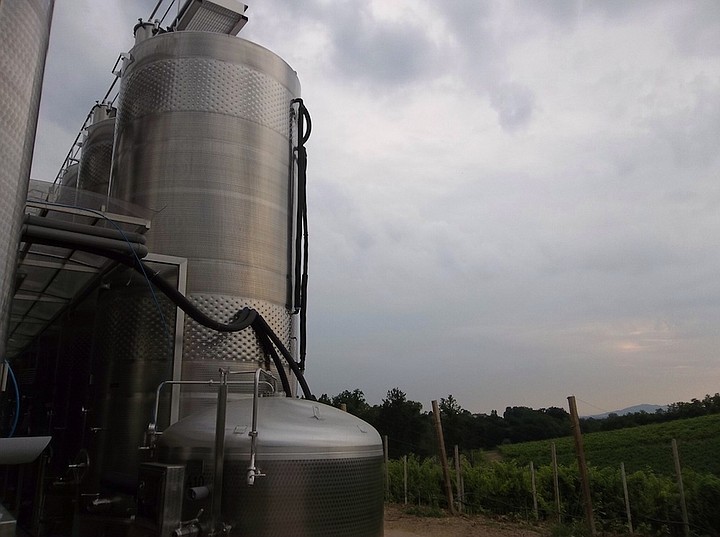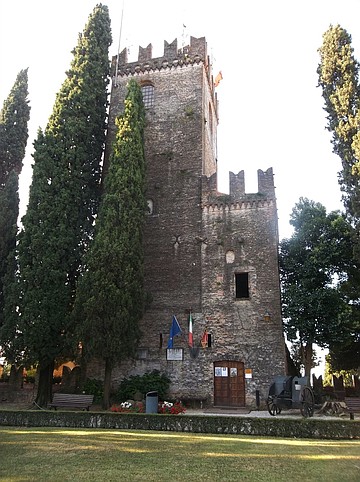 Facebook
Facebook
 X
X
 Instagram
Instagram
 TikTok
TikTok
 Youtube
Youtube

Rome, Venice and Florence are all amazing experiences, but it’s also nice to just relax in a small Italian village with the locals and experience Italian culture in a different way.
Few Americans have heard of Conegliano, a small town in the foothills of the Dolomite Alps about an hour outside of Venice. I stayed there with a local family while visiting Venice and found it to be a village worth exploring, with its own advantages and points of interest.

The family I stayed with, my wonderful Servas hosts Alessandra and Angelo, made sure I did not leave without some understanding of Conegliano’s finer qualities and noble heritage. After arriving by train and being picked up by Angelo, I was immediately whisked off for some wine tasting. We headed to an estate near a vast expanse of vineyards and huge grain silo–looking contraptions called pigiatrices (left) that smashed the grapes (no more jumping and dancing on the grapes to make wine, like in the old I Love Lucy episode).
I was given a sample of some the finest dry and sparkling Prosecco wines by the one English-speaking member of the wine-producing family.
“This one is marketed to America,” she proudly pointed out, urging me to give it a sip.
Who was I to turn her down? Tranquilo (still). Frizzante (slightly sparkling). Spumante (sparkling). Bianco. Rosso. I gave them all a taste. It was a fine way to prepare for the spectacular sights in Venice the next day.
We then had a risotto dinner at the home of my hosts, which was actually located in San Pietro di Feletto, adjacent to Conegliano. I helped them peel pears from the tree in the front yard as we discussed their interest in an affordable exchange program for their son to visit America.
A few mornings later, before my departure to Milan, Angelo did a wonderful job (despite his limited English) showing me the highlights of Conegliano.

First on the agenda was the local castle of Conegliano.
“It’s not that old,” Angelo told me. “It dates back to the year 1000.”
Whoa right there.
I explained that in California, “old” has an entirely different meaning. Our missions seem ancient to us, and those are only about 250 years old.
We meandered up the narrow road to the castle which was, as most castles seem to be in Italy, at the highest point in town. (Thank goodness for small Italian cars!) The castle was impressive, but just a remnant of what it once was. Only the tower remains, housing a museum. Heavy stone walls once surrounded the castle and the adjoining community to ward off invaders. We enjoyed a spectacular view of the village, the green valley and the surrounding hills – a wonderful setting for the musical performances that are often held on the castle grounds.

We then descended into central Conegliano, where the weekly Friday market covered several blocks of the downtown area. I was particularly intrigued by the cheese market. The Italians take their cheeses seriously, and the market gave indication of this; several varieties were proudly displayed.
Angelo showed me the impressive theatre, the Scuola dei Battuti, at the Piazza Cima, and the historical spots related to the most famous local historical figure, the Renaissance painter Giovanni Batista Cima, also known as Cima da Conegliano. Cima, recently described in The Economist as “an overlooked master,” studied under the more famous Renaissance master, Bellini, whose works I had admired the day before in Venice. The local cathedral features an amazing altarpiece by Cima, The Enthroned Madonna and Child. Cima’s home, a block from the cathedral, has been restored and is now a museum containing replicas of his most significant works. I was impressed by the enthusiasm and pride Angelo exuded while showing these to me.
After Angelo headed off to work, I visited the local tourist office, which was more than happy to provide me with several brochures and pamphlets detailing the food, wine, art, architecture, history and other attractions of the Treviso province, which includes Conegliano. I discovered that the oldest wine-growing school is nearby and that in late June there's a popular chess tournament in town, the Dama Castellana, featuring real people as players with different local neighborhoods competing against each other.
What a lovely contrast visiting here was to the jostling crowds in Venice. As perhaps the most romantic city in the world, Venice is difficult to rival – but there’s something about the local charm of a small village and its inhabitants that also touch the heart and offer perhaps an even more valuable insight into the culture.


Rome, Venice and Florence are all amazing experiences, but it’s also nice to just relax in a small Italian village with the locals and experience Italian culture in a different way.
Few Americans have heard of Conegliano, a small town in the foothills of the Dolomite Alps about an hour outside of Venice. I stayed there with a local family while visiting Venice and found it to be a village worth exploring, with its own advantages and points of interest.

The family I stayed with, my wonderful Servas hosts Alessandra and Angelo, made sure I did not leave without some understanding of Conegliano’s finer qualities and noble heritage. After arriving by train and being picked up by Angelo, I was immediately whisked off for some wine tasting. We headed to an estate near a vast expanse of vineyards and huge grain silo–looking contraptions called pigiatrices (left) that smashed the grapes (no more jumping and dancing on the grapes to make wine, like in the old I Love Lucy episode).
I was given a sample of some the finest dry and sparkling Prosecco wines by the one English-speaking member of the wine-producing family.
“This one is marketed to America,” she proudly pointed out, urging me to give it a sip.
Who was I to turn her down? Tranquilo (still). Frizzante (slightly sparkling). Spumante (sparkling). Bianco. Rosso. I gave them all a taste. It was a fine way to prepare for the spectacular sights in Venice the next day.
We then had a risotto dinner at the home of my hosts, which was actually located in San Pietro di Feletto, adjacent to Conegliano. I helped them peel pears from the tree in the front yard as we discussed their interest in an affordable exchange program for their son to visit America.
A few mornings later, before my departure to Milan, Angelo did a wonderful job (despite his limited English) showing me the highlights of Conegliano.

First on the agenda was the local castle of Conegliano.
“It’s not that old,” Angelo told me. “It dates back to the year 1000.”
Whoa right there.
I explained that in California, “old” has an entirely different meaning. Our missions seem ancient to us, and those are only about 250 years old.
We meandered up the narrow road to the castle which was, as most castles seem to be in Italy, at the highest point in town. (Thank goodness for small Italian cars!) The castle was impressive, but just a remnant of what it once was. Only the tower remains, housing a museum. Heavy stone walls once surrounded the castle and the adjoining community to ward off invaders. We enjoyed a spectacular view of the village, the green valley and the surrounding hills – a wonderful setting for the musical performances that are often held on the castle grounds.

We then descended into central Conegliano, where the weekly Friday market covered several blocks of the downtown area. I was particularly intrigued by the cheese market. The Italians take their cheeses seriously, and the market gave indication of this; several varieties were proudly displayed.
Angelo showed me the impressive theatre, the Scuola dei Battuti, at the Piazza Cima, and the historical spots related to the most famous local historical figure, the Renaissance painter Giovanni Batista Cima, also known as Cima da Conegliano. Cima, recently described in The Economist as “an overlooked master,” studied under the more famous Renaissance master, Bellini, whose works I had admired the day before in Venice. The local cathedral features an amazing altarpiece by Cima, The Enthroned Madonna and Child. Cima’s home, a block from the cathedral, has been restored and is now a museum containing replicas of his most significant works. I was impressed by the enthusiasm and pride Angelo exuded while showing these to me.
After Angelo headed off to work, I visited the local tourist office, which was more than happy to provide me with several brochures and pamphlets detailing the food, wine, art, architecture, history and other attractions of the Treviso province, which includes Conegliano. I discovered that the oldest wine-growing school is nearby and that in late June there's a popular chess tournament in town, the Dama Castellana, featuring real people as players with different local neighborhoods competing against each other.
What a lovely contrast visiting here was to the jostling crowds in Venice. As perhaps the most romantic city in the world, Venice is difficult to rival – but there’s something about the local charm of a small village and its inhabitants that also touch the heart and offer perhaps an even more valuable insight into the culture.
Comments